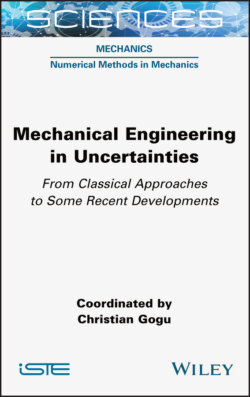Читать книгу Mechanical Engineering in Uncertainties From Classical Approaches to Some Recent Developments - Группа авторов - Страница 10
Оглавление
Preface
Christian GOGU
Clément Ader Institute, Paul Sabatier University, Toulouse, France
This preface is intended to thank all those who contributed to this book and to establish the context of each contribution.
First of all, I would like to thank Sylvain Drapier, professor at the École des Mines de Saint-Étienne, whom I had as a professor during my studies and whom I subsequently worked with at the Tribology and Systems Dynamics Laboratory, where I completed my PhD thesis concerning the identification of mechanical properties under uncertainty. In charge of the topic “Numerical modeling in mechanics” for the new Sciences encyclopedia launched by ISTE Editions, Sylvain Drapier invited me to be the editor of this work and I thank him for the trust he has placed in me.
I would then like to give my warm thanks to Maurice Lemaire, Professor Emeritus at IFMA/SIGMA Clermont and Scientific Advisor to Phimeca, for agreeing to write the foreword of this book. I met Maurice a long time ago, and came to know him personally first and then professionally. He has pioneered the research on considering uncertainties in mechanical engineering and it is an honor to have his contribution to this book.
Thereafter I would like to thank all the authors of the different chapters in this book, while establishing the context of each of their contributions in order to highlight the structuring and articulation of the book.
Without being exhaustive, this book aims to present a number of fundamental concepts and classical approaches, as well as several recent developments and advanced methods. It is divided into two parts, each with four chapters. The first part is dedicated to the modeling, quantification and propagation of uncertainties. The second part is dedicated to taking uncertainties into account through reliability analyses and optimization under uncertainty.
Chapter 1, which I have written, aims to review a number of conventional uncertainty modeling methods. It also seeks to introduce a number of notations and terminologies. A distinction is specifically made between random and epistemic uncertainties, and the different modeling methods associated with each are presented, illustrated and discussed.
Chapter 2, written by François Willot, illustrates the use of probabilistic tools to characterize environments exhibiting a microheterogeneous structure, a typical example of which is concrete. Such a characterization of “random” microstructures makes it possible to later return to a statistical characterization of macroscopic properties, necessary to characterize the reliability or robustness of the structures.
Chapter 3, written by David Bouhjiti, Julien Baroth and Frédéric Dufour, illustrates methods of uncertainty propagation on large civil engineering structures, in this case containment facilities for nuclear power plants. It discusses the essential notions of variability of material properties and their characterization by random fields. The stochastic finite-element technique, as well as several improvements, is then introduced in order to achieve the propagation of random fields to the quantities of interest.
Chapter 4, co-authored with Sylvain Dubreuil, Nathalie Bartoli and Thierry Lefebvre, presents a new method for characterizing and then reducing uncertainties, due to the use of substitution models based on Gaussian processes within multidisciplinary analysis. This method is illustrated with a classical example of multidisciplinary coupling, in this case, a fluid-structure coupling on an aeronautical wing.
Chapter 5, written by Jean-Marc Bourinet, reviews a large number of methods for calculating the probabilities of rare events, typically failure probabilities. The reader will find an introduction to the fundamental concepts and to these different methods for calculating failure probabilities.
Chapter 6, written by Cécile Mattrand, Pierre Beaurepaire and Nicolas Gayton, reviews a number of relatively recent developments associated with a certain type of method, known as the adaptive method, for calculating the probabilities of failure. These methods are based on the use of kriging surrogate models and their adaptive enrichment, in order to calculate failure probability with the most moderate numerical cost possible.
Chapter 7, written by Vincent Chabridon, Mathieu Balesdent, Guillaume Perrin, Jérôme Morio, Jean-Marc Bourinet and Nicolas Gayton, proposes a new method for the calculation of the (global) sensitivity of the probability of failure, taking into account the uncertainty regarding the parameters of the distributions, characterizing the variabilities of the problem. This method is illustrated by an example in the field of space launchers.
Chapter 8, written by Quentin Mercier and Fabrice Poirion, presents a new method for solving stochastic multiobjective optimization problems and, more particularly, those where the expectation of the different objectives is to be optimized. It is also shown how this formulation can be used to efficiently solve optimization problems under reliability constraints, by reformulating them as multiobjective optimization problems.
